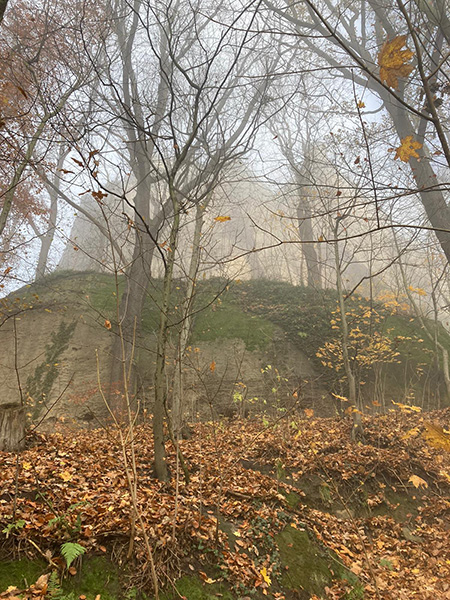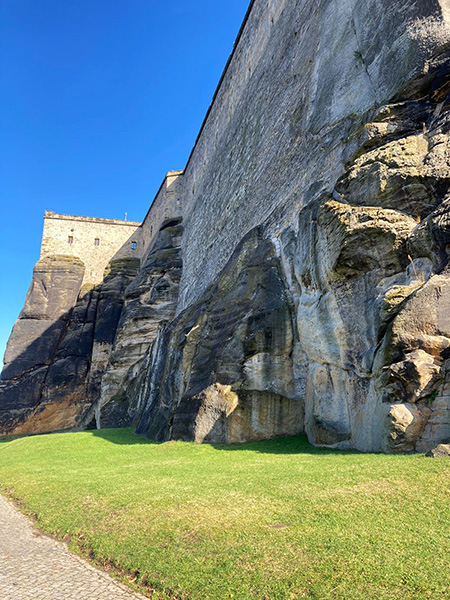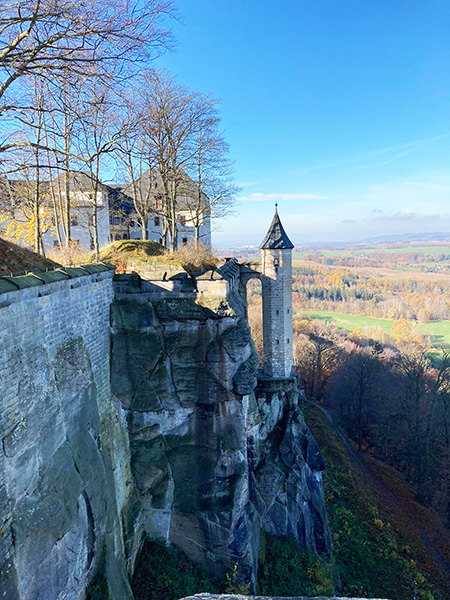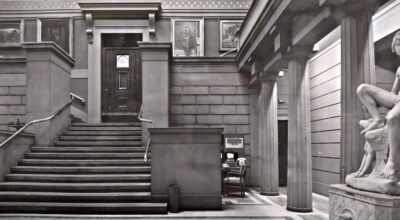The steep and ancient path through the forest was challenging, to say the least. Far below gleamed the serene waters of the River Elbe, but the way ahead seemed interminable. At last, after so many forlorn hopes, the ghostly form of a fairytale castle suddenly loomed through the trees and mist.
Königstein : A Real Life Encounter In 2021

It is only when you stand at the base of the fortress that you begin to grasp just what a thing of wonder it truly is. The formidable walls seem to be a living extension of the massive sandstone rock that underpins them. Indeed, all the modifications over the centuries present us with a cross section through time – with layers of human endeavour somehow mimicking the geological structure beneath.

The opportunity to complete an almost unbroken circuit of the battlements is an especially welcome surprise for the first time visitor. Along the way, you encounter a succession of little architectural marvels and it soon becomes very clear indeed as to why Königstein has proved so consistently impregnable.

To gaze down into the spectacular river valley is also to contemplate a vast well of history and drama. Back in 1756, the year of Bernardo Bellotto’s arrival at Königstein, his employer Friedrich Augustus II of Saxony, did exactly that, only to witness the surrender of his entire army to the forces of Prussia’s Frederick the Great on the opposite bank. Friedrich Augustus was unassailable in his fortress – but by the same token, found himself powerless to influence the world beyond or prevent such an important turning point in the Seven Years War.

I had arrived at Königstein from Dresden at an exceedingly early hour and soon discovered that I had the whole place pretty much to myself. Consequently, as I wandered through the inner gardens and courtyards, I experienced much of the tranquility that Bellotto conveyed so beautifully in our beloved Manchester Art Gallery masterpieces. Indeed, there is something powerfully moving about being able to stand at the very vantage points from which he had made his first sketches.

And all those buildings that we know so well from the Manchester paintings – including the Brunnenhouse and Magdalenenburg – still stand proud, like old faithful friends. Missing of course, were the little swirls of human energy that the artist skillfully introduced into those touching little vignettes and anecdotes, so evident in both works. And so it fell to me to imagine that I was actually in the midst of all that companionship and purpose – and that I too was sharing in the conversation, gossip and bonhomie. But then again, that was not at all difficult – in such a setting, the echoes and shadows of our forebears are easily sensed.
Volunteer Guide, John Ward visited Konigstein in Saxony on 9 November 2021.
John will be delivering an in-person public tour entitled ‘Bellotto’s Königstein: a Witness to History’ on Saturday 22 January and Saturday 29 January 2022, 11 – 11:45am in Gallery 15. See our event calendar for more details.



